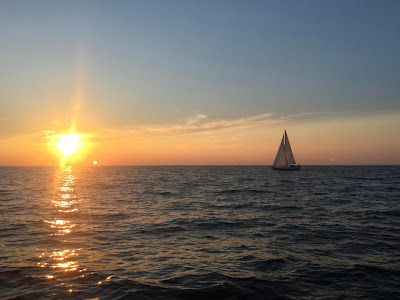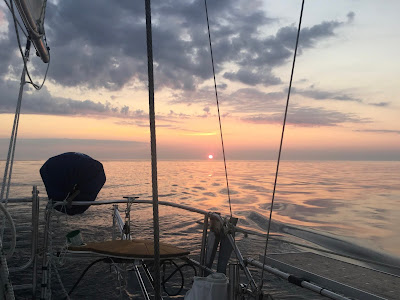The three-hour trip from Great Kills to Atlantic Highlands was uneventful and we motorsailed all the way in a light breeze. We were very happy to move to Atlantic Highlands, a quaint cruiser-friendly waterfront community. After picking up our mooring, we hailed the launch to go to shore. We quickly got a sense of the place. Within walking distance there were several coffee shops, a couple of ice cream parlors, numerous restaurants, laundry facilities, a supermarket, and a multi-screen movie theater. The launch service ran from early morning until 11 pm. We could use it as many times as we wanted and it was free (included in the mooring fee).
We spent a couple of days in port waiting for a weather window. It was still hot (in the 90s, 35+C) and humid so one afternoon we decided to go to the movies to cool off. When we got out of the movies, the sky looked dark and gray so we rushed to get the launch back to Rosalind. We got on board and soon after we started seeing lightning to the west. I thought that the storm was going to miss us and the first part did but before long we were in the middle of a severe thunderstorm. The severe weather was supposed to be over by 7 pm, then 8 pm, then 9 pm...The severe thunderstorms lasted until well after midnight and they caused major damage. The marina and surroundings lost power, cars floated away, a sailboat mast got struck by lightning in the mooring field (I saw it happen) and overall it was a big mess. We watched from inside Rosalind's cockpit enclosure but after the lighting strike in the mooring field we spent a lot of time down below. Wind was gusting to 35+ knots (65+ km/h) and Rosalind and the other boats were getting tossed around. Our anchor riding sail helped us a lot and we were swinging around a lot less than the boats around us.
We turned in late and used the next day to relax and do some provisioning. It looked like we were going to get a good 24-hour weather window so we got Rosalind ready and left Atlantic Highlands the following morning at 10:00 am.
 |
| Sunset off the New Jersey Coast |
We were monitoring traffic on both AIS and RADAR and we saw a slow-moving oil exploration platform/ship that we passed on our port side. A little over 4 miles (7.5 km) behind us was the ship Skipjack. On the AIS, Skipjack was showing a closest point of approach (CPA) of about two miles (3.5 km) then, in a mater of a few minutes, the CPA went to zero! We got on the radio and hailed Skipjack. The Captain immediately responded. Yes, he was aware of us; he had us on RADAR and he could see our masthead light too (from 4.3 miles or 8 km away). He was maneuvering to give the oil platform plenty of room and would head back out to sea as soon as he cleared it. The rest of the night was uneventful. We did track a number of targets on RADAR and the automatic tracking feature (MARPA) proved useful again.
Shortly after dawn we arrived at the Cape May Inlet where we were greeted by a pod of dolphins! It had been a great 24 hour sail! After navigating the inlet, we dropped the hook to the north of the Coast Guard Station in 12 ft (3.5 m) of water.
We spent several days in Cape May going to shore, walking, seeing the beautiful Victorian homes, and provisioning. We found a great coffee shop: Out There Coffee. The coffee was great, the prices very reasonable, and the owners friendly. The shop even had gluten-free treats! We took all of their gluten-free almond cake slices for the rest of our trip back home and as soon as we got a good weather window we left Cape May for Delaware City.




No comments:
Post a Comment